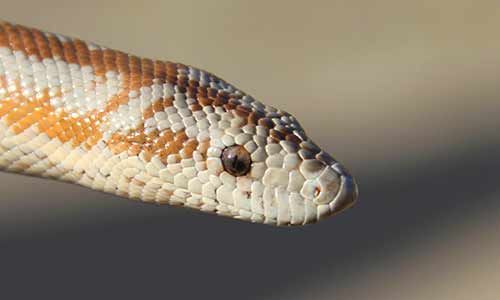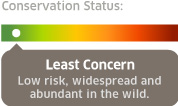Rosy Boa
Lichanura trivirgata

About the Rosy Boa

Geographic Range:

Class: Reptilia
Order: Squamata
Family: Boidae
Genus: Lichanura
Species: trivirgata
Among the smallest members of the boa family, the rosy boa prefers the rocky terrain of the southwestern United States and northwestern Mexico. The rosy boa compensates for its vulnerable size with a clever way of warding off predators—rolling itself into a ball with its head in the center, and then releasing a foul-smelling musk from a gland in its tail. This habit of coiling around its own head appears to make it difficult for predators, like birds of prey, to kill or even handle a rosy boa.
Rosy Boa Facts
Appearance:
The rosy boa is one of the smallest members of the boa family. It has a heavy-bodied build, a short, blunt tail and small head. Its eyes have elliptical pupils like those of a cat. They are beige, blue or rose colored with three lengthwise gray, tan or reddish brown stripes, and the underside is creamy or gray with black flecks. Individuals from the coast and foothills may be nearly a uniform gray or brown color, with less defined stripes. Individuals from the desert tend to exhibit a more distinct pattern of stripes. Like other members of the boa family, the rosy boa has two claw-like spurs near its vent, attached to bones inside its body. These anal spurs are vestigial hind legs inherited from the boa's lizard ancestors.
Size:
Length: 22.4–35.4 inches
Diet:
Rosy boas feed on warm-blooded prey, such as small mammals and birds. Like its larger relatives, they kill prey by constriction.
Reproduction:
Rosy boa breeding season takes place in the spring, after which soft eggs are retained and developed inside the female for a gestation period of four months. Females give live birth to up to 12 offspring.
Behavior:
These snakes are usually most active at dusk and at night, and they're diurnal in early spring. In early spring, or in cooler coastal areas, they may be active during the day. Rosy boas are primarily terrestrial but will also climb low shrubs. They spend much of their time hiding under rocks.
The rosy boa compensates for its vulnerable size with a clever way of warding off predators—rolling itself into a ball with its head in the center, and then releasing a foul-smelling musk from a gland in its tail. This habit of coiling around its own head appears to make it difficult for predators, like birds of prey, to kill or even handle a rosy boa.
Habitat/Range:
The rosy boa inhabits desert foothills with rocks and boulders from sea level to 4500 feet. This snake prefers rocky terrain where crevices make safe homes. Occasionally, it is spotted in shrub lands or chaparral without rocky areas. The rosy boa is restricted to southern California, southwestern Arizona, and northwestern Mexico.
Median Life Expectancy:
10-15 years
You Can Find This Animal in the Animal Discovery Center
You May Also Like
At Franklin Park Zoo:
At Stone Zoo:


